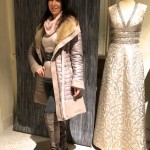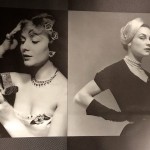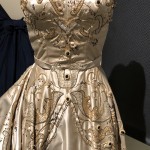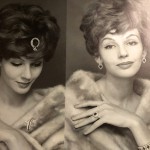Storie di eleganza
19 Marzo, 2020 Published in Events | Fashion | Jewellery
Un abito per una donna è sempre stato come una bacchetta magica, l’indossarlo ci trasforma in quell’immagine di bellezza che sogniamo. La forma dell’eleganza è cambiata nel corso dei secoli, senza mai perdere la sua essenza e la sua straordinarietà. E’ bello cominciare un racconto che ci parla della moda attraverso i tempi, dell’abilità e della creatività sartoriale e dei gioielli che hanno reso gli abiti ancora più straordinari. Un racconto da vivere percorrendo le sale di Palazzo Morando per scoprire il lusso femminile di un tempo, fondamento ed esempio del nostro presente. Un abito è qualcosa di speciale, ma lo diventa ancora di più grazie alla donna che lo indossa.
Iniziamo con gli abiti degli anni ’50, molto femminili e influenzati dallo stile parigino. Le importanti sartorie milanesi, così come le gioiellerie, erano concentrate nel quadrilatero della moda. Tra i grandi nomi ricordiamo: Cusi, Calderoni, Chiaravalli, Scavia, Buccellati, Antonini, Faraone, Schreiber e Sabbadini. Era un mondo splendido ricco di luci, colori, proporzioni, maestria e business nel quale si respirava un’aria sublime e appagante all’insegna del bon ton.
Gli eleganti e fantasiosi anni ’60 traggono ispirazione dall’arte, dal design e dal desiderio dei giovani di un abbigliamento meno formale e più creativo. Sono gli anni delle grandi sperimentazioni. Maruccelli collabora, tra gli altri, con Getulio Alviani con cui creerà la moda Op, basata sull’illusione ottica e l’impressione plastica del movimento; Mila Schön propone la lavorazione double, fondata sull’accoppiamento di due tessuti e senza cuciture a vista, e una collezione ispirata ai tagli di Lucio Fontana. L’oreficeria crea gioielli “da giorno” in oro giallo, a volte abbinato a pietre colorate, e gioielli “da sera” in platino e diamanti da sfoggiare nelle occasioni mondane, come la prima della Scala. Talvolta il colore fa capolino nelle parure più formali con l’inserimento di pietre preziose e semipreziose.
Gli chic e folk anni ’70 risentono del movimento hippy. I giovani indossano semplici tuniche in cotone naturale, sandali, pantaloni a vita bassa e a zampa di elefante, gilet a fiori, camicie annodate sopra l’ombelico e lunghe gonne arricciate. In questi anni gli importanti produttori di tessuti riempiono i laboratori sartoriali di pannelli a foulard dalle fantasie meravigliose. L’austerity fa disertare sempre di più le occasioni mondane. I gioielli hanno uno stile moderno e lineare con dettagli colorati creati con lo smalto oppure da inserti di pietre dure. Vengono creati anche gioielli meno impegnativi e più ‘democratici’ che si adattano al nuovo prêt-à-porter.
Gli edonistici anni ’80, eclettici, glamour e rock, vedono il ritorno dell’Alta Moda e un amore per l’eccesso e l’opulenza. Non solo le donne della borghesia e della nobiltà ma anche le donne che si affermano nel lavoro sono le clienti ideali, desiderando consolidare il loro ruolo anche attraverso l’abito che indossano. La “Milano da bere” riscopre il Foyer della Scala e Raffaella Curiel ne diventa la regina. L’oro, il re dei metalli preziosi, diviene protagonista indiscusso, anche se cominciano varie sperimentazione di forme e materiali.
Negli anni ’90 si ritorna a una certa sobrietà e, vista la concorrenza del prêt-à-porter, gli atelier si focalizzano quasi esclusivamente sui grandi eventi come matrimoni, balli e prime della Scala, realizzando capi unici e speciali. Le gioiellerie milanesi creano oggetti di grande valore estetico per una clientela più ristretta e consapevole del valore della tradizione
Negli anni 2000 si esplorano nuove frontiere e si desiderano abiti che ci diano la sensazione esserci stati cuciti addosso. Il “su misura”, le sontuose lavorazioni e i ricami diventano l’oggetto del nostro desiderio. Nel settore del gioiello si fanno strada nuove tecnologie, progettazioni e l’uso di materiali innovativi. Si è nel frattempo acceso un vivo interesse per le tecniche, le lavorazioni e i materiali d’un tempo che diventa preziosissimo tramandare per non rischiare di perderli.
La mostra STILE MILANO è stata realizzata dall’Associazione Culturale STILE E STORIA in collaborazione con il Comune di Milano e prestigiose realtà milanesi come la Camera di Commercio di Milano e la Camera Nazionale della Moda.
A dress for a woman is like a magic wand, wearing it we turns into that image of beauty that we dream. The shape of elegance has changed over the centuries, without ever losing its essence and its extraordinary soul. Is nice to start a story that tells to us about fashion through the times, the skill, the sartorial creativity and the jewels which have made the clothes even more extraordinary. A story to live through the Palazzo Morando halls to discover the past feminine luxury, the foundation and the example of our present. A dress is something special, but it becomes even more special thanks to the woman who wears it.
Let’s start with the very feminine and influenced by the Parisian style clothes of the 50s. The important Milanese tailors, as well as the jewelleries, were concentrated in the fashion quarter. Among them: Cusi, Calderoni, Chiaravalli, Scavia, Buccellati, Antonini, Pharaoh, Schreiber and Sabbadini. It was a beautiful world full of lights, colors, proportions, mastery and business in which there was a sublime and satisfying air of bon ton.
The elegant and imaginative 60s drew inspiration from the art, the design and the desire of young people for less formal and more creative clothing. These were the years of great experimentation. Maruccelli collaborated, among others, with Getulio Alviani to create the Op fashion, based on optical illusion and the plastic impression of movement; Mila Schon proposed the double workmanship, based on the union of two fabrics and no exposed seams, and a collection inspired by the Lucio Fontana cuts. The jewellers created “day” yellow gold jewelry, sometimes enriched with colored stones, and “evening” platinum and diamonds jewels for worldly occasions, such as the “La Scala”premier. Sometimes the color peeped into the most formal parures with the insertion of precious and semi-precious stones. The chic and folk 70s felt of the hippie movement. Youngsters wore simple natural cotton tunics, sandals, low-waisted and flared trousers, flower waistcoats, curled skirts. In these years the leading fabric manufacturers filled the tailoring workshops with scarves with wonderful patterns. There were less life style events because of the austerity opportunities desert. The jewels had a modern and linear style with colorful details created with enamel or hard stone inserts. Less demanding and more ‘democratic’ jewels were also created to be adapted to the new ready-to-wear. The hedonistic, eclectic, glamorous and rock 80s saw the return of high fashion and a love for excess and opulence. Not only the women of the bourgeoisie and the nobility but also the women who asserted themselves in the work was the ideal clients, wishing to consolidate their role also through the dress. The “Milan to drink” rediscovered the Scala Foyer and Raffaella Curiel became its queen. Gold, the king of precious metals, became the undisputed protagonist, even if various shapes and materials experimentations began.
In the 90s we returned to a certain sobriety and, because of the competition of ready-to-wear, the atelier focused almost exclusively on the big events such as weddings, balls and “La Scala” premieres, creating unique and special dresses. The Milanese jewellers created great aesthetic value objects for a smaller clientele and awarded value to the tradition. In the 2000s we explored new frontiers and wanted clothes which gave us the feeling to be sewn on us. The “tailored made”, the sumptuous manufactures and embroidery became the object of our desire. New technologies, designs and the use of innovative materials were being developed in the jewellery industry. In the meantime, there had been a keen interest in the techniques, processes and materials and became invaluable to hand on to not risk losing them.
The “STILE MILANO” exhibition was created by the Cultural Association STYLE AND HISTORY in collaboration with the City of Milan and prestigious Milanese companies such as the Milan Chamber of Commerce and the National Chamber of Fashion
www.stilemilano.it – www.facebook.com/Stile-Milano – www.facebook.com/dolcissimame.it/






